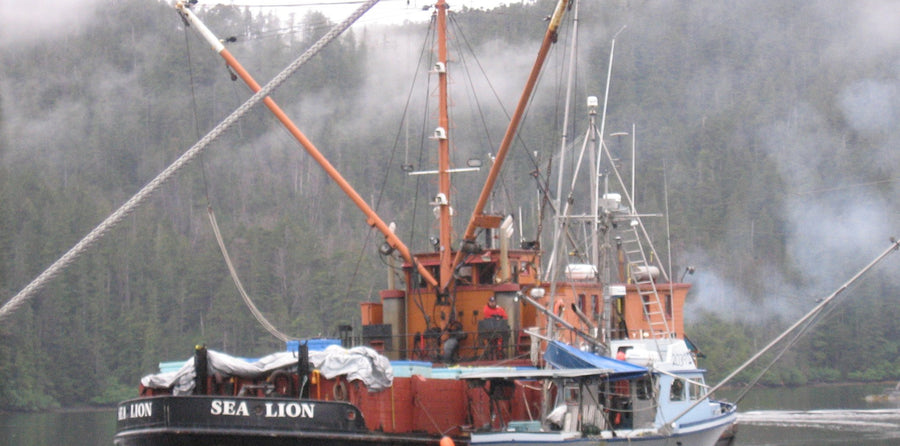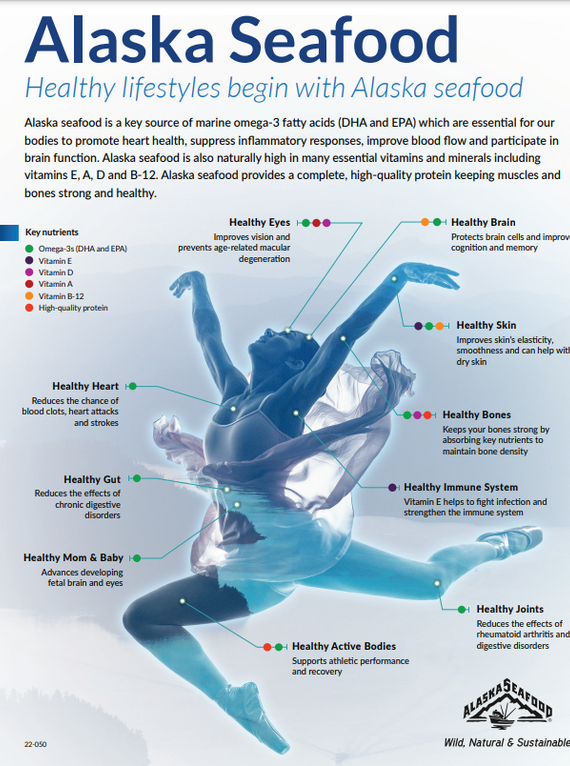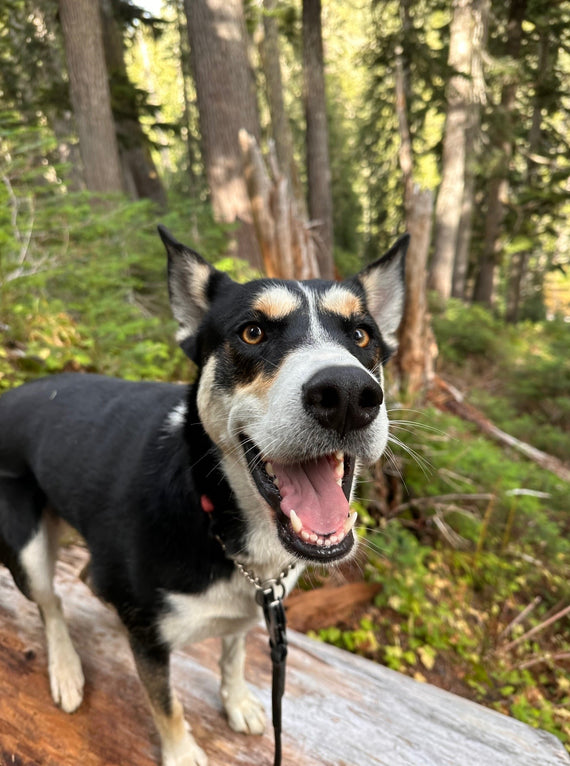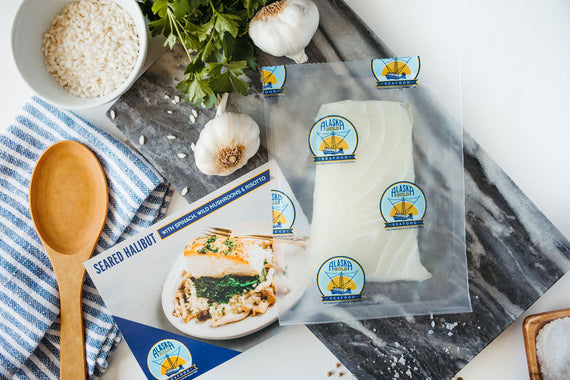
In our Sitka-based fishermen-owned co-op, we see a lot of fish and we see a lot of wooden boats. As an Alaska Gold Seafood fish monger, I like to get out and see it all in action. And the perfect opportunity came recently when I could hop on the Sea Lion, our salmon-buying scow, for trip through the waters of southeast Alaska. A buying scow, or tenders as we call them, is a boat that meets our fishermen where they are on the grounds to buy their salmon and service them with fuel, ice, and groceries. This service is essential to the troll fleet and preserves a unique way of life that I try to show through this set of journal entries and the next one on community.
The Sea Lion is a boat built in 1946 for the Bristol Bay herring fishery. At 86.5 feet, the Sea Lion can pack a lot of salmon and get it back to our processing plant in Sitka, thus allowing fishermen to fish the drags further away from town. The Sea Lion went from being a herring boat to a salmon tender for the Bristol Bay fleet but sat idle for a while when the Bristol Bay fleet slowed down a bit in the 1970s. Our co-op’s president Norm Pillen owns the Sea Lion. As president, Norm has been busy in our Sitka plant, managing operations and communicating with the fleet. He’s had a good crew help run the boat over the years. One of the fishermen in our fleet, Gary McMaster, has a nephew from South Carolina, Greg McGuire, who has been on the Sea Lion since 2015, and Greg has also been captain of the Sea Lion. Greg knows the ins and outs of the Sea Lion’s wheelhouse, engine room, hoist, and maybe more importantly, how to interact with fishermen to give them the best service so that they can keep doing what they do. Greg now runs the Sea Lion this season.
I spent a few days on the Sea Lion and saw some beautiful country, iced lots of fish, and spent some time visiting with fishermen to see what it’s like buying wild Alaskan line-caught salmon out on the grounds. Here’s my journal for those days…
July 19th, 2022
I meet Captain Greg at our Sitka plant and we go and pick up the last bit of groceries for the trip and some groceries to deliver to fishermen who don’t have time to go back to town and want to stay out fishing out on the grounds. I throw my bag onto the deck and Greg takes my mandolin, as I take the steep ladder down the Sitka sea wall onto the Sea Lion’s deck.
I’m a bit apprehensive, as it’s been a while that I’ve been on a boat, but excited to see the coast of Baranof Island, the surrounding area, meet some fishermen, and hold some beautiful fish in my hands.
The big diesel engines fire up and by 1 o’clock, we leave the Sitka Harbor with dozens of totes of ice and head out to the ocean, passing sea otters and a pile of sea lions on a rock. The Sea Lion is an appropriate name, as sea lions also pack on a lot of salmon.
While rounding the corner at Biorka island, we get into the bigger ocean swells and then start heading south along the beautifully rugged Baranof Island coast and all its jagged bays and dramatic mountain peaks. I catch up with the Sea Lion’s crew—Wes, Greg’s brother, and Christian, Greg’s cousin’s significant other. Like all food operations right now—dining, production, distribution—the Sea Lion is shorthanded and I will help out. Not a passenger or a tourist, I will try to be as helpful as a greenhorn can be. Wes is a veteran on the Sea Lion and is a great deck boss, constantly working to make sure we are making Greg’s job operating the boom easier. Christian has been a deckhand on several fishing boats for salmon and black cod. Young and eager with a back only someone under 30 could have, he shows me the ropes and moves the heavier totes that I can barely budge.
It’s a long run to our first stop and the ocean is a little roll-y from a swell from a recent storm. The best thing to do for seasickness for me is just to look at the horizon and that’s what I do, enjoying the views. I see puffins, murres, murrelets, and other seabirds. We pass bays I’m familiar with, including the bay where I first gaffed a king salmon on a salmon trolling boat as a deckhand a few years ago. I watch some trollers working the pinnacles, their trolling poles bouncing along in the distance in that familiar rhythm of trolling vessels. I can imagine what’s happening on the boat deck and what the fishermen are thinking. I have a tremendous urge to hop on one of those trolling boats and gaff a king salmon, but I know our job on the Sea Lion isn’t catching salmon but buying salmon.
I don’t like closing my eyes with the roll-y seas, but as the evening wears on I can’t keep my eyes open anymore and eventually retire to the bunk of my state room. It’s by the Sea Lion’s massive engine room and loud enough to cover up all my other thoughts, and I fall asleep instantly.
Eventually, after one of the more pleasant sleeps I’ve had in weeks, I hear the engine noise cool off a bit. And check my watch. 1am. We’re now at a lull in a bay. Table Bay on Kuiu Island. Too tired to do anything else, I go back to sleep in the relative quiet.
July 20th, 2022 Table Bay, Kuiu Island
At 6am, we pull further into the back of Table Bay, our anchorage for the day. “7 fathoms,” Greg announces over a speaker system and the crew drops the anchor. Greg says there were too many fishing boats anchored up in the bay last night for us to get a good spot, so he waited for them to leave in the morning before pulling into the back of the bay. I check out the view of otters cruising around the little bay where we’re anchored. Greg says there’s a whale that lives in this bay and I keep my eye out while bouncing in the swell.
Rain begins in earnest around 7:15am and we get our first call from fisherman Cavin Pfeiffer on the Caribou. Cavin’s out “family fishing” with his kids, but then he decides to head back to town to pick up his wife and doesn’t pay us a visit. There’s still a swell on the bay and I watch the waves pound the rocks in the distance. One inch of movement on the boat from the swell means about one foot of movement on the hoist, so the swell is not ideal for buying salmon, because it means that the crane operator has to give 100% focus in order not to lose control of the cargo. 600 pounds of fish and ice can pound into a delivering fisherman or the Sea Lion crew if Greg is not careful with the boom. Or the load can get stuck while being lifted out of the hold.
It’s a lot of caffeine and odd hours. By early October, Greg knows he can sleep in and relax a bit again, and that’s what keeps him motivated during the grueling summer salmon buying season where he needs to keep at least one eye open for just about 24 hours a day. Once October hits, the winter king salmon season begins, and fishing boats are limited to inside waters closer to town, so no tenders are needed.
In general, tendering is a waiting game and learning how to manage boredom. Most of the fishermen will wait for the evening or the afternoon lull before coming to the bay to sell to the Sea Lion. But weather, the “bite,” or other whims might otherwise determine their decisions, and our job is to be ready when they are. Sometimes their decisions are rational—weighing how much fuel they have to burn could sway them to drive back to town or deliver their fish to the tender. Other times it could be irrational. If they’re only going to deliver 30 fish and pick up some ice it’s not worth it for the tender to go 3 hours out of their way to make that trip. As an owner of the co-op, the fisherman should understand that that’s a demand that doesn’t help his overall bottom line. But still there’s the demand to have a tender available for any stop for any service the fishermen need.
We get word that our outport in Craig, on Prince of Wales Island, has well over 1000 fish ready to be picked up by the Sea Lion and brought back to Sitka. Most likely we’ll stay in Table Bay to buy fish from fishermen delivering this evening and the first boats coming off the morning bite the following day. And then make the run to Craig. But plans change. You can’t make plans too firm with this business because with nature things change. As we wait, I read the entire Albie and Billy, the Sky Pilot, and Other Stories by Wayne Short, an old local fisherman and author of The Cheechakoes. I relish in the old timers’ stories of sourdough fishermen eking out an existence in the Alaskan wilderness.
I think about the drama of the anadromous cycle of the salmon. An inch long out of a creek, they head downstream past larger fish—trout, dolly varden, and more—and waterfowl like ducks, gulls, eagles and ospreys, that would make a breakfast of them. Eventually they’ll make it to a brackish bay and the next big transition. To salt water. It seems like a miracle that the salmon make it even this far. And then they head to the great ocean. The salmon over time will swim out past the Aleutian islands and possibly the international date line. Then they head south as they feed and grow, following “feed” to fatten up. And they keep spinning in the Pacific Gyre. Depending on the species, they might spend a year or two or four, and then sometime early one summer they turn east for the last time, and hopefully back to the creek where they were born. The ones that make it all the way back—these are survivors. And that’s perhaps what earns the fishermen’s respect. The fishermen that can make it commercial fishing in Alaska, with its vicissitudes of weather and heavy seas and the whims of nature and consumer markets, are survivors, too. They can see that in the salmon and there’s a genuine respect.
Finally, around 6-6:30pm, Matt Lichtenstein on the Aurora, came into our bay to deliver some salmon. With the Aurora’s troll poles raised, so he can tie up on the Sea Lion, Wes and Christian quickly tie up the Aurora. We unload some excellent quality, gorgeous king salmon and coho salmon, with just a few fish number 2-ed for shark bite scars. Number 2s, in our business, are the fish with some defects, one step lower than a number one. In the case of troll-caught salmon, on which a fisherman has labored intensely to maintain the quality, number 2s usually come from cosmetic defects, like scars from birds or sharks.

A former reporter and employee with Fish & Game, Matt’s also an EMT, which is good news for him and his deckhand. We have a nice visit with Matt chatting about all the characters out on the water in this area. We share some cookies baked on the Sea Lion by Jaesha from our Sitka office, the last person to work helping out on the Sea Lion.
The cookies are a reminder of a little detail that is so important on a tender boat: Good service to fishermen is so important when they’re out doing back-breaking and dangerous work. A tender that gives them some respite from the ocean—its swells, the waves and wind that pound into you all day—is priceless. This service is also part of what we do at Alaska Gold Seafood for our customers. We’re here to help!

A salmon trolling boat tied up to the Sea Lion to deliver salmon.
With each boat, Greg operates a boom that pulls totes of fish out of the hold of the trolling boat, lowers them onto a table for Wes, Christian and I to grade. Grading the salmon is essentially sorting the salmon by species and quality. Christian tells me the king salmon has a “soul patch,” like a dark goatee under his chin, and thick spots on the tail, and this is how I can tell a huge coho salmon from a small king. A pink salmon will also have those dark spots on the tail, but is usually much smaller, and has very tiny scales. A keta salmon has more white around the gills and more yellow-ish glowing eyes. A sockeye salmon has a greener hue and a solid line down the side. Sometimes it’s really not clear and I double-check with Wes, Christian and Greg. And sometimes even they make mistakes, but we’re always double and triple-checking each other. When they are ocean-caught salmon, they are all silver-y bright and much more difficult to distinguish than when they get close to their home rivers, when they begin taking on spawning colors.
I was told by Norm before getting on the boat, “If you hear the hydraulics, it means the boom is being operated, so be aware.” And as I hear the hydraulics, I always remain cognizant of where I am on the boat deck in relation to whatever 600-pound tote of fish or ice being moved around. Once the fish are graded, they are put in a tote again by grade in order to be weighed. We also do a sample temperature check on three fish to make sure they were iced properly by the fishermen on their boats. And once weighed, then we do the same thing ourselves, making sure each salmon’s belly is full of ice. Within our fishermen-owned co-op, we use the highest quality ice as part of maintaining quality from boat to plate. It’s a small detail that goes a long way, as we show in this post on the best time to eat Alaskan seafood. What doesn’t go noticed sometime is the that for each boat that ices up, the crew of the Sea Lion takes time to break up the ice for them. I will never forget the sound of a 600-pound bag of ice thumping on a boat deck after being dropped from 20 feet up, as Greg uses the boom to heave the bag up and then Christian would pull a line to release the bag from the hoist and it slams to the deck as he would jump out of the way. This breaks up the ice into smaller flakes to better get into each crevice of the fish and makes the ice easier to work with for the fishermen icing their salmon.
In our chat with Matt, particularly fascinating to me are his tales of geoduck divers and the idea that these divers who spend a lot of time in relatively deep water digging for geoduck clams have communications radios and listening in to their conversations underwater can be quite amusing, with grunts and curses being traded back and forth to entertain the general radio-operating public. He also talks about a diver that had apparently drowned and then came back to life but whose brain has been a bit fried by the experience. Both Matt and his deckhand take a quick shower on the Sea Lion. Captain Greg fills out the paperwork for the check for buying salmon from Matt, deducting the $957 in fuel and $246 in groceries we handed to him, always a reminder of the costs of going fishing and the all-important difference between gross and net sales. As a co-op owner, Matt “pools” his catch, which means that he gets an upfront price for his salmon, but at the end of the season, if the co-op performs profitably, he’ll also get a share of the profit.
At around 7pm, Lindsay Johnson and her partner Graham on the Sika pull into to deliver salmon to us. An exhausted crew brings in a good load of king salmon, coho salmon, and a couple of lingcod. Along with others delivering to us in this bay, they might have been fishing the Crowley Bight where there’s a drag that is popular with trollers.
I don’t know when, but sometime during the day Greg made for us the most delicious beef stew with a secret sauce from a local Sitka steak house, the Channel Club and by 9:30 we’re chowing down. It was a busy night for me, but just on the quiet side for the Sea Lion crew. The stew tastes so good.

7-21-22 Table Bay, Kuiu Island
Alec on the Carolyn L comes in at 5am with a load of king salmon, coho salmon and keta salmon. I realize just how gorgeous these salmon are when they’re this ocean bright in color. By 6am we’re on our way out of Table Bay and heading to Port Alice. As we make our way out of Table Bay, the humpback whale that lives there bobs its head up to wave goodbye to us.

51F and a bit overcast, but the sun threatens to come out. It’s a gorgeous sunrise over the hilly terrain on the island. With the crazy light from the sun splitting through the thick southeast Alaska clouds, lines from the old Peter Rowan song “Midnight Moonlight,” an Old & In the Way tune I play on my mandolin, come to mind:
And the ocean is howling
With dreams that might have been
The last good morning sunrise
Will be the brightest you’ve ever seen…
It’s glassy smooth on our run to Port Alice on Hecate Island, and we pass the Cape Decision lighthouse at 8am. It looks like a rickety train track and bridge heading out to the lighthouse. I sit by Greg in the wheelhouse as we slide between Warren and Kosiusko islands, observing salmon trolling boats out in the distance. Murres, puffins and other small waterfowl are sitting on top of “feed” balls—schools of needlefish, herring, or other small fish. Most likely, salmon are down there, too. “Birds just don’t gather like that for no reason,” Greg notes. We pass another small island, really just a collection of rocks, and it blows my mind that there are trees on it with the salt water and wind pounding them day in and day out.
At noon we arrive at Port Alice and buy salmon from a couple of boats. Paul on the New Adventure and Brett Stillwaugh on the McKenna S. It’s trying to be sunny, and for southeast Alaska, you might even call it sunny. Fortunately, it’s still glassy smooth. And we’re off again at 3:15pm. This time for Hole in the Wall on San Lorenzo island. Hole in the Wall is really just a small channel between two rocks of the same island. We get there around 6pm and immediately start unloading boats. We buy a big load of salmon from Raymond Douville, a highliner from Craig on the Faith, which means that the fishermen after him will have to wait along while for us to finish unloading the salmon we buy from the Faith. We don’t finish unloading until just before midnight. Today we’ve bought, unloaded, loaded, graded, and iced around 13,725 pounds of salmon if my math is right.
See Part 2 of Buying Wild Salmon on the Sea Lion here.



